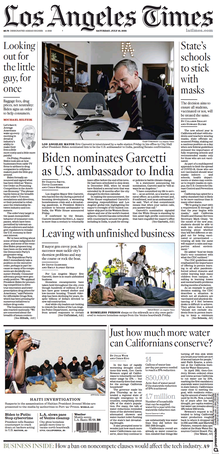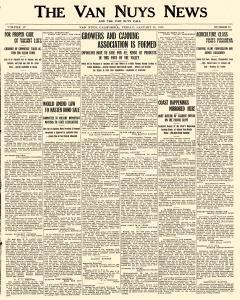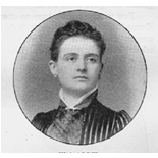
Hearst Communications, Inc., often referred to simply as Hearst, is an American multinational mass media and business information conglomerate based in Hearst Tower in Midtown Manhattan in New York City.
The Chicago American was an afternoon newspaper published in Chicago, under various names until its dissolution in 1975.

The Los Angeles Times is a daily newspaper that started publishing in Los Angeles in 1881. Based in the Los Angeles County city of El Segundo since 2018, it is the sixth-largest newspaper by circulation in the United States, as well as the largest newspaper in the western United States. Owned by Patrick Soon-Shiong and published by the Times Mirror Company, the paper has won more than 40 Pulitzer Prizes.

The San Francisco Chronicle is a newspaper serving primarily the San Francisco Bay Area of Northern California. It was founded in 1865 as The Daily Dramatic Chronicle by teenage brothers Charles de Young and Michael H. de Young. The paper is owned by the Hearst Corporation, which bought it from the de Young family in 2000. It is the only major daily paper covering the city and county of San Francisco.

Louella Parsons was an American gossip columnist and a screenwriter. She was retained by William Randolph Hearst because she had championed Hearst's mistress Marion Davies and subsequently became an influential figure in Hollywood. At her peak, her columns were read by 20 million people in 700 newspapers worldwide.

The Los Angeles Herald Examiner was a major Los Angeles daily newspaper, published in the afternoon from Monday to Friday and in the morning on Saturdays and Sundays. It was part of the Hearst syndicate. It was formed when the afternoon Herald-Express and the morning Los Angeles Examiner, both of which were published there since the turn of the 20th century, merged in 1962.

The Sun was a New York newspaper published from 1833 until 1950. It was considered a serious paper, like the city's two more successful broadsheets, The New York Times and the New York Herald Tribune. The Sun was the first successful penny daily newspaper in the United States, and was for a time, the most successful newspaper in America.

The Los Angeles Daily News is the second-largest-circulating paid daily newspaper of Los Angeles, California. It is the flagship of the Southern California News Group, a branch of Colorado-based Digital First Media.

The Press-Telegram is a paid daily newspaper published in Long Beach, California. Coverage area for the Press-Telegram includes Long Beach, Lakewood, Signal Hill, Artesia, Bellflower, Cerritos, Compton, Downey, Hawaiian Gardens, Lynwood, Norwalk and Paramount.

The San Antonio Express-News is a daily newspaper in San Antonio, Texas. It is owned by the Hearst Corporation and has offices in San Antonio and Austin, Texas. The Express-News is the third largest newspaper in the state of Texas, with a daily circulation of nearly 100,000 copies in 2016. The newspaper's online presence includes both the subscription version of the San Antonio Express-News and the ad-supported mySA.
The Daily Breeze is a 57,000-circulation daily newspaper published in Hermosa Beach, California, United States. It serves the South Bay cities of Los Angeles County. Its slogan is "LAX to LA Harbor".
The Santa Barbara News-Press was a broadsheet newspaper based in Santa Barbara, California. It was founded in 1868 as the Post and merged with the rival News to form the News-Press in 1932. On July 21, 2023, it filed for bankruptcy and ceased publication.

Joseph Pomeroy Widney, M.D. D.D. LL.D, was an American doctor, educator, historian, and religious leader.

Yda Hillis Addis was the first American writer to translate ancient Mexican oral stories and histories into English, some of which she submitted to San Francisco-based newspaper The Argonaut. The most widely popular of her more than 100 stories are Roman's Romance and Roger's Luck.

The Los Angeles Examiner was a newspaper founded in 1903 by William Randolph Hearst in Los Angeles. The afternoon Los Angeles Herald-Express and the morning Los Angeles Examiner, both of which had been publishing in the city since the turn of the 20th century, merged in 1962. For a few years after this merger, the Los Angeles Herald Examiner claimed the largest afternoon-newspaper circulation in the country, publishing its last edition on November 2, 1989.

Carl Greenberg was an American newspaper reporter who began as a police reporter; most of his career he was a reporter covering California and U.S. national politics. He worked for the Los Angeles Examiner until it closed in 1962; later he worked for the Los Angeles Times and became its political editor.

The history of newspapers in California dates back to 1846, with the first publication of The Californian in Monterey. Since then California has been served by a large number of newspapers based in many cities.

The Los Angeles Herald-Express was one of Los Angeles' oldest newspapers, formed after a combination of the Los Angeles Herald and the Los Angeles Express. After a 1962 combination with Hearst Corporation's Los Angeles Examiner, the paper became the Los Angeles Herald-Examiner folding on November 2, 1989.

The Los Angeles Express was a newspaper published in Los Angeles in the late 19th and early 20th centuries. Founded in 1871, the newspaper was acquired by William Randolph Hearst in 1931. It merged with the Los Angeles Herald and became an evening newspaper known as the Los Angeles Herald-Express. A 1962 combination with Hearst's morning Los Angeles Examiner resulted in its final incarnation as the evening Los Angeles Herald-Examiner.
Grace Kingsley was the first motion-picture editor and columnist of the Los Angeles Times, beginning the position in 1914 and ending when she retired in 1933.

















